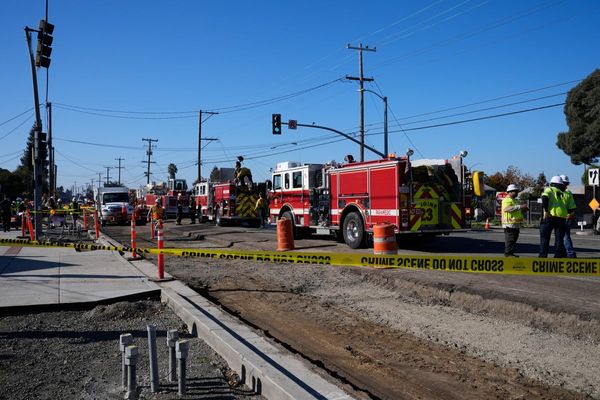
Americans are bracing for the impact of the largest cuts to the government’s food assistance program for low-income people in US history that have begun to take effect as a result of Donald Trump’s One Big Beautiful Bill Act.
Effective 1 October, the beginning of fiscal year 2026, funding for Snap-Ed, part of the Supplemental Nutrition Assistance Program (Snap) that provided funding for food banks across the US, is being eliminated. The cuts are part of the sweeping spending bill Trump signed in July.
A report this month by the Center on Budget and Policy Priorities noted “some low-income families will see their food assistance terminated or cut substantially (or will be denied benefits) this fall, though most current participants will face cuts when their SNAP eligibility is next recertified,” with estimates that 4 million Americans in a typical month will lose some or all of their Snap benefits when the cuts are fully implemented.
A Snap recipient in Camden county, New Jersey, who works as a cake decorator at a small business and requested to remain anonymous, said their Snap benefits were cut off in September without receiving a notice.
“Snap was my way to finally not pay half to three-quarters of my paycheck on groceries. Now, I have nothing in my house regularly and it just feels like no one wants to help people any more,” they said. “I only got a little over $110 a month, but it helped tremendously.”
They said it’s made it more difficult to work at a job they love, but that doesn’t pay enough.
Jessica Griffin of Fort Smith, Arkansas, a mother of three, said she lost her job about five months ago and has struggled to find another, with her family relying on her husband’s income.
After rent and utility bills, there isn’t much left over to buy groceries and she doesn’t have reliable transportation to get to food banks, she said.
“I used to be able to buy $100 worth of groceries a week to feed a family of five, now even with one child out of the house $100 will only go a couple days,” she said. “The rent rates are so high now as well as groceries that families can barely afford to feed their kids and keep a roof over their heads at the same time. So it almost feels like we have two options, to either live in a house or live on the street and not starve.”
Funding cuts to states, which will be expected to share costs of Snap for the first time as well as cover more administrative costs, are phased for fiscal years 2027 and 2028, but several provisions and changes to Snap are being implemented as states have to grapple with drastic costs shifted on to them from the federal government.
“States don’t have enough administrative staff or capacity to handle this,” said Gina Plata-Nino, interim Snap director at the Food Research and Action Center. “I think we’re on a downward path. Polling and data is showing that one of the biggest obstacles that people are having in being able to eat is just how expensive food is at the moment. This is a direct result of tariffs and other policy choices that the administration has made. It’s something that everyone, regardless of income, can understand.”
The looming Snap cuts come as food prices are still rising under the Trump administration and are expected to continue rising due to tariffs and labor shortages in the food industry due to Trump’s immigration policies.
From January 2022 to August 2025, overall food cost in the US increased by about 17.8%, according the consumer price index, and has increased 2.0% since January 2025, when Trump took office. Trump’s tariffs are expected to drive further increases, with food prices set to rise 3.4% in the short term and stay 2.5% higher in the long run, according to the Yale Budget Lab.
Food banks have been struggling across the US to keep up with demand and manage rising food prices, while bracing for further cuts, higher prices, and a surge in demand once Snap cuts begin taking effect.
At a food bank in Charlottesville, Virginia, Jane Colony Mills, executive director of Loaves & Fishes, said the food bank has “experienced a 20% increase in the numbers of people coming for food assistance in 2025, likely driven not only by the cost of groceries in our community, but by the overall cost of living in Charlottesville and Albemarle area.”
She noted their food supply has decreased as well, since they rely on food that stores cannot sell, and have also been affected by cuts at the US Department of Agriculture (USDA) to programs that support food banks. Colony Mills noted Snap cuts haven’t taken effect yet in Virginia, but local social service departments are bracing for those reductions or cancellations starting 1 October.
“People who rely on these incremental supports will be struggling even more to provide food for their households each month,” she added.
In Washington, the Thurston County Food Bank said they are bracing for significant cuts to Snap that will increase demand and make it more difficult to meet the current demand, let alone handle increases. They have already had to lay off staff positions funded by the Snap-Ed program that was cut by the Trump administration.
“We have been told to brace for cuts that could be as much as 20% to 25% of the food we received in prior years. For us, 25% is $1m worth of food in 2024 prices, so with rising food costs, we can assume that is a gap of well over a million dollars,” said executive director of the Thurston County Food Bank.
Ahead of the cuts to Snap and rising food prices, the Trump administration announced the cancellation of the annual hunger survey that measures food insecurity in the US and food researchers at the USDA were put on leave.
USDA deferred comment to a press release, where they claimed “these redundant, costly, politicized, and extraneous studies do nothing more than fear monger.”
The decision is viewed by anti-hunger advocates as an effort by the Trump administration to obfuscate the impacts of their cuts to Snap and other policies affecting food insecurity for Americans.
“By cancelling the survey, USDA is sending a signal that tracking and battling hunger is no longer a priority,” Eric Mitchell, president of the Alliance to End Hunger, said in a statement. “It is further troubling that the decision comes amid predictions that hunger may increase in the coming months and years. Hunger will not disappear simply because it is no longer tracked.”







